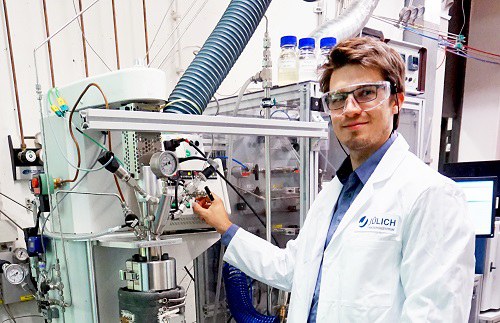Half the effort, same results
Scientists from Jülich and Erlangen simplify hydrogen storage
Jülich / Erlangen, August 29th, 2017 – Scientist of the Forschungszentrum Jülich and the Friedrich-Alexander University of Erlangen (FAU) have developed a method using which hydrogen storage becomes much simpler. It reduces the technical effort required for the chemical bonding of hydrogen to organic carrier liquids: Instead of two apparatuses, as was previously the case, only one apparatus is now used, which handles both charging and discharging of the carrier liquid. Future industrial use of the process can significantly reduce the costs and energy required for hydrogen storage - a potentially important step for energy transition.

Publication: Hydrogen storage using a hot pressure swing reactor, H. Jorschick, P. Preuster, S. Dürr, A. Seidel, K. Müller, A. Bösmann and P. Wasserscheid, Energy & Environmental Science, DOI: 10.1039/c7ee00476a
The sun and wind are expected to provide most of our energy in the future. However, these regenerative sources deliver their energy depending on the weather, which makes efficient forms of energy storage necessary. One solution to this problem is hydrogen: The universally applicable energy carrier can be extracted from water using regenerative energy and used to generate electricity again as needed.
To store the hydrogen and transport it where needed, scientists at FAU and the Helmholtz Institute Erlangen-Nuremberg for Renewable Energies (HI ERN), a branch of Forschungszentrum Jülich, have developed a special process: an organic carrier liquid ("Liquid Organic Hydrogen Carrier", or LOHC for short) that can bind more than 650 liters of hydrogen per liter and with which the chemically bound hydrogen can be stored safely and transported cost-effectively. "Hydrogen storage and release from the carrier liquid occurs through a reversible chemical reaction," explains Holger Jorschick of HI ERN. "Previously, a special catalyst was required for each reaction direction, as the pressure and temperature of the two reaction steps were significantly different. Therefore, LOHC loading with hydrogen and the release of hydrogen from the LOHC carrier had to occur in two separate reaction units."
Affordable and energy-saving
The team of scientists from Forschungszentrum Jülich and FAU, led by Prof. Peter Wasserscheid, has succeeded in developing a catalyst that can efficiently accelerate the charging and discharging reaction at the same temperature. Using this catalyst, hydrogen storage and release can be achieved in one apparatus simply by changing the pressure, which implies huge savings. "The expensive part of LOHC plants are usually the tools - valves, pumps, the measurement and control technology," explains Dr. Patrick Preuster of FAU's Department of Chemical Reaction Engineering. "Since these are only needed for one apparatus instead of two with the new catalyst, about 30 to 50 percent of the costs can be saved." In addition, the space required for the plant and the operating costs are reduced.
The new process offers another major advantage for the efficient use of the reaction heat released during hydrogen storage. "Previously, the loading apparatus had to be operated at around 150 degrees Celsius, and the unloading apparatus at around 300 degrees," says Holger Jorschick. "Although the same amount of heat is released during loading that has to be supplied during unloading, it was impossible to store the heat released during loading and use it for unloading because of the different reaction temperatures." The new process allows the hydrogen storage tank to be loaded at higher temperatures - the heat generated can be temporarily stored and used for the unloading reaction.
Switching in a split second
"It was only with the high-temperature hydrogenation we developed - and a catalyst that is effective for both reactions - that it became possible to run both reactions in one apparatus," says Patrick Preuster.
The new storage method has a particularly favorable effect on the dynamic operation of such equipment. Whereas in the conventional process with two separate apparatuses, the required apparatus has to be started up in each case, which is time-consuming and energy-intensive, with the new method an apparatus ready for operation is available immediately. "By simply switching a valve, it is possible to switch from storage to discharge operation and vice versa in a split second," explains Preuster.
The process has virtually no disadvantages. However, Holger Jorschick admits that possible application places are limited: "Of course, it is nonsensical to keep the apparatus constantly at operating temperature by storing or releasing hydrogen. But we assume that in a future, strongly regenerative energy system, there will be great demand for such equipment." Exactly when the process will be ready for use on a commercial scale is not yet certain. Until now, it has only been tested on a small laboratory scale. But Holger Jorschick is confident: "There will be a technical prototype by the end of the year."

Contact persons:
M. Sc. Holger Jorschick
Forschungszentrum Jülich, Institut für Energie- und Klimaforschung,
Helmholtz-Institut Erlangen-Nürnberg für Erneuerbare Energien (IEK-11)
Tel.: 09131 85-28331
E-Mail: h.jorschick@fz-juelich.de
Dr.-Ing. Patrick Preuster
Friedrich-Alexander-Universität Erlangen-Nürnberg,
Lehrstuhl für chemische Reaktionstechnik
Tel.: 09131 85-67421
E-Mail: patrick.preuster@fau.de
Press office:
Dr. Regine Panknin
Forschungszentrum Jülich, Unternehmenskommunikation
Tel.: 02461 61-9054
E-Mail: r.panknin@fz-juelich.de
Dr. Susanne Spörler
Forschungszentrum Jülich, Institut für Energie- und Klimaforschung,
Helmholtz-Institut Erlangen-Nürnberg für Erneuerbare Energien (IEK-11)
Tel.: 09131 85-20249
E-Mail: s.spoerler@fz-juelich.de
